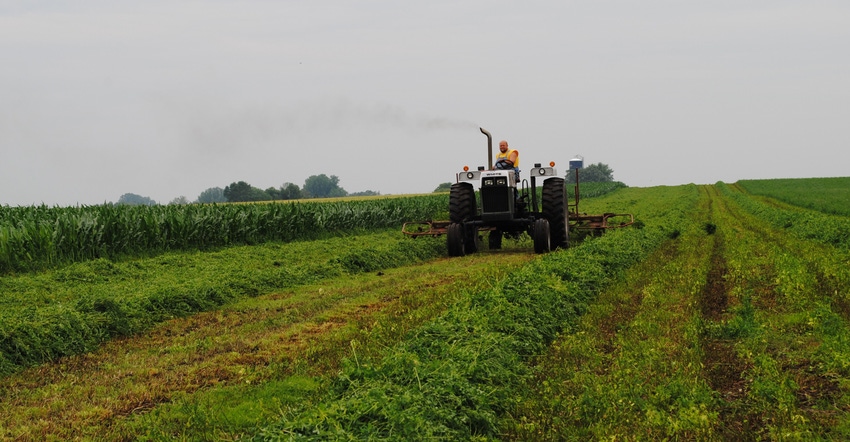
Farmers usually begin harvesting alfalfa after they finish planting corn, according to Jerry Clark, Extension crops and soils agent in Chippewa County, Wis.
“If they are delayed by rain and it’s time to start harvesting alfalfa or put the soybeans in, I would hope they would make the hay and trade the soybeans in for a shorter-day variety. Harvesting alfalfa is always a top priority on a dairy farm,” Clark says.
Clark says there are 10 top tips producers need to focus on when it comes to harvesting alfalfa. The No. 1 tip is to stay safe in the field.
1. Make safety the top priority. “We always get in a hurry, and if rain is coming, we try to go faster and we sometimes forget to stay safe,” Clark says. “Slow down and focus on what you are doing.”
2. Harvest at the proper moisture. “That’s where you are going to make a quality product,” Clark says. For a bunker silo, ag bags and piles, aim for 65% to 70% moisture, he says. For a tower silo, start harvesting when the alfalfa is between 60% and 65% moisture, and for baleage, around 35% moisture. For dry hay, make sure the alfalfa is between 13% and 17% moisture.
3. Manage your cutting schedule. “Your cutting schedule is going to set the stage for the rest of the year,” Clark says. “Make sure you get your fields cut as quickly as you can. You want to avoid having a cutting schedule that is scattered throughout the summer, which can happen if you cut one field and it rains and you are delayed a few days.”
4. Make hay when the sun shines. “Watch the weather. If you get a window of dry weather, that may be the time to take that hay,” Clark says. “Maybe it’s not quite time to take the hay, but it’s dry — ‘make hay when the sun shines’ as they say.”
5. Strive for rapid drydown. Get alfalfa dried down to the proper moisture. “Make the windrows as wide as possible,” Clark says. “The quicker we can get that hay dried down to the proper moisture, the better.”
6. Watch wheel traffic. Don’t drive randomly across the field. “Limit wheel traffic as much as possible,” he says. “Five to 10 days after cutting, yield is reduced 6% for each day you are driving on the hay after cutting, usually due to breaking stems from driving over it. The quicker you can get it off after cutting, the better.”
7. Track quality of the growing crop. Use scissors-cut sampling or a Predictive Equation for Alfalfa Quality stick to estimate when the quality is optimum for harvest, Clark says.
“With the PEAQ stick or scissors cut, you always figure about 20 points less than what it says because of storage and harvest losses,” he notes. “So, if it says 170 relative feed value, it’s actually going to feed out at 150 RFV, or 20 points less than what it says. If you are shooting for 150 RFV, you want to start harvesting when your PEAQ stick says 170. Track quality as best you can.”
8. Scout fields for plant development. You can start to estimate when to cut by crop scouting if you are not using scissors-cut sampling or a PEAQ stick. “Look for potato leaf hoppers,” Clark says. “Look for any diseases, yellowing or nutrition deficiencies. You can move up your cutting schedule to manage the pest that way rather than spray and wait.”
9. Get equipment ready. “Minimize breakdowns by making sure your tractors, mowers, choppers, balers, and trucks or chopper wagons are maintained and ready to go,” he says.
10. Prepare storage. “Make sure you have the plastic for your bunkers and piles. Check to make sure you have silage bags, and the bagger is ready or the silo unloaders are raised and working,” Clark says. “This is something you can work on when it is raining.”
About the Author(s)
You May Also Like






